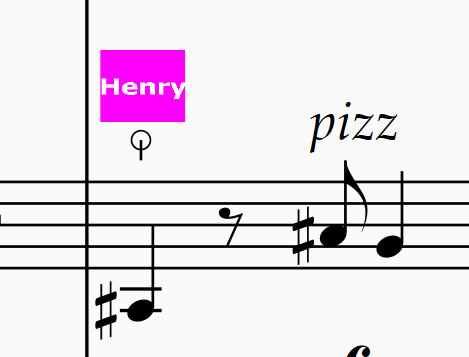Leaderboard
Popular Content
Showing content with the highest reputation on 01/30/2025 in all areas
-
I'm stil not done with my orchestrations, I will probably come to this section a bunch of times this year haha. What do you think? I believe I managed to portray a dark aura. I still don't know how to assign dynamics to the instruments, any advice for that so I don't have to rely on "mp" and "ppp" so much?1 point
-
Durante partimento 13.pdfThis is my first real realization of Partimento that I am confident in with Durante no 13. I would appreciate some feedback on it. Thank you!1 point
-
1 point
-
Hello guys! I wanted to share what i made in past 3 month or so. Sorry for puting all that in one topic, but i dont want to spam with eight topics(i feel like there is enough of my threads here already) 😄 1) This was my "next big project". Worked very hard on this one. I wanted it to be my first good song, aaaand the outcome was quite dissapointing for me: https://youtu.be/OatILQS25gY This made me rethink my approach. I lowered my expectations and just went with the flow. Wanted to have fun instead of forcing myself trying to make something good at all cost. If it will came to be not great, whatever i did my best 😄 And this led me to couple of shorter stuff: 2) Simple positive stuff had a blast making it https://youtu.be/PXX0JjmGGEM 3) Short guitar solo https://youtu.be/gWJIvDYl_BQ 4) Also short one it has kinda adventure game vibes https://youtu.be/TiZu430nJMI 5) then i made this piano and strings piece https://youtu.be/a_16tih-w14 6) then this kinda jjazzy piano and trumpet https://youtu.be/ubU7rqCK4tY 7) And then a bit longer piece. Its kinda messy and all over the places but i like it 😄 https://youtu.be/HDRdTTanTEI 8 ) (i had to make space after 8 because emote in glasses was popping out xD) And this is the last one. It's sad. I was feeling sad. It came to be like that. https://youtu.be/PMhJnwxe2Jw Aaaaand thats all. Sorry for lllong post and take care 🙂1 point
-
Hi @General Pokopo, I listen to the tracks and wish to give some feedback: I don’t think you should disappoint with this one. You set up the mood quite well in my opinion; maybe just add some spices and wow factors would it more exciting! This one really sounds like drinking! For me this one sounds like a harpsichord! Sounds exciting! This one sounds chic! Sadly the trumpet doesn’t sound too real here. This one sounds quite funny and varied in style haha. This one sounds quite strange for me personally, I don’t know how to describe it. Thx for sharing and congrats on your works within just 3 months’ time! Henry1 point
-
Hey Peter, Thx for your two valuable reviews! Yeah maybe the contrast of brightness is what I want there. I myself am quite confused at using the Locrian scale to open the movement at the first place, but I still keep it to see what will happen next, and like @Mooravioli said I did want to try some new scales after a rather monotonous first movement. The Locrian scale would be again used nihilistically in the third movement. The Locrian scale followed by the pentatonics would be used again the coda of the entire sonata, so stay tuned! Yeah I deliberately try to be chaotic in that two spots, and I think it succeeds if not too chaotic! There I try to use the Locrian figure in the left hand to make it more chaotic! Yeah it’s intentional. It’s like I as the sufferer want to take a deep breath and just listen to my mind of an imaginary idealistic world of pentatonics, hence forgetting to tell my own tales and omit the melody. I myself find the moment rather poetic to be honest hahahahaha! Yup I like this passage very much. I must have been inspired by Chopin’s 4th Ballade with the counterpoint. Yeah I also try to avoid exact repetition except it”s necessary to do so. I myself find the exact repetition in a lot of the recapitulation of a sonata or reprise of a rondo boring, so I avoid doing that myself. I always think a sense of development and progress is important as the piece goes on, and varying the main theme would be a way to develop the piece. As in here, the main theme here is more and more involved with the pentatonics, hence for me it’s like the sad me more and more in touch with the idealistically peaceful world as Vince @Thatguy v2.0 had noted. Yup the main theme is basically just a pentatonic scale, so I make use of it and make a scale like variation of it as an accompaniment as well. The rhythmic diminution must be adapted by my playing of Beethoven’s op.111 and Brahms. I know it has to flourish at the end, so I just diminish the value progressively to make it more natural! Thx for your reviews! Henry1 point
-
Hi @Alex Weidmann, I just listen to this as an entirely new work. I don’t find the harmony wild at all. I like the harmony in b.40. And I like the wilderness in b.49 section. For the structure I think it works for me as a ternary ABA. The feeling would be a bit sad in the outer sections and agitated in the middle section. I think your music always remind me of Vaughn Williams. Thx for sharing! Henry1 point
-
I thought I'd start another topic in the series of previous topics like "Songs or pieces that never hit the tonic?" and "Tracks that use cross relations or polymodality?" This time I'm looking for tracks, songs, or pieces that never use the dominant level chord. I have one specimen from popular rock music that seems to satisfy this requirement: "Wishing" by Electric Light Orchestra The harmony is as follows in A major: Intro: ||: I | iv | I | bVII :|| Verse (x2): ||: I | vi | iii | ii | iii | ii | bVII :|| Chorus: ||: IV | I vi | bVII | iii | ii | bVII :|| Verse Instrumental Solo Chorus Intro Verse (x2) Chorus Verse Outro (repeated Intro) Harmonic commentary: One could argue that the bVII acts like a backdoor dominant chord which is a common harmonic trope in jazz and rock music. Each section of the song ends with the bVII which could be said to function as a dominant. Also, in Bartok's Axis Theory of chord functions encompassing the whole chromatic scale, the bII, iii, V and bVII all function as dominant chords. Either way, I included this song since it doesn't include a traditional V7 resolving to the tonic. Thanks for listening and reading!1 point
-
Hello Henry This is an impressive composition and I really enjoyed that you performed it yourself. This is quite demanding but you managed very well to play it. I listened to it several times and will try to give you my impressions. This work is coherent and well structured, with the primary melody present in most of the piece. But I think that it is often a bit heavy, particularly the part after the second melody. The thick repetitive structure of chords (in bar 86 and 98) as well as many of the fast running arpeggio´s can work OK, but attract too much attention, and obscure rather than enhance the melody awareness. I would try to avoid too many of such embellishments, unless they have a very clear purpose (I should not really say this because I make this kind of mistake too often myself). A very beautiful part starts from bar 39 (typically Chopin-type style).Also the music in bar 56-59 is very good - great work! In bar 60-63, I can unmistakably identify your personal style. After a rather complex narrative, there are nice resolutions in bar 89 (and also in 101), and a pleasant and clear return to the primary melody ( but things remain still a bit heavy). The sudden interruption of the melody line after bar 126 evoked a bit of a question. I did not quite understand the idea. And the arpeggiated chords in 129-130 were too “thick” for my taste. The start of a Coda in 138 is nice and should perhaps be noted as tenuto (at least this is the way you seem to play it, and I like it). In the ending of bar 142, I would prefer a simplification, by just using the top E, instead of the diads in the groups of 4 notes (and everything played pp). The overlay repetitive pentatonic style is not my cup of tea, but OK, this is just me. It is more a question of personal taste. When looking at the score, I found some other (minor) things which I would do differently: 1) In bar 4 of the preamble, I would replace the half note (C-sharp) and the E (with the fermata), with three quavers: C sharp – E and F-sharp, (played slower of course and adjusted with an appropriate metre) . I think it would provide a nicer transition to the subsequent start of the melody. 2) The augmentation from the B to a C in bar 8 (and also bar 16) in the l.h.chords seems unnecessary to me. It detracts the attention on the melody In the case of bar 12, the situation is quite the opposite. Here, the augmentation is excellent! 3) In bar 14 (and also bar 30), the last two quaver chords in the l.h.are a bit jarring for me. 4) In bar 26, I would change the last r.h. diad to a triad: (F-sharp – A – B). It provides a better transition to the next E-major chord. I did not have time to look at the more complex part of the score , but I hope that my ideas make some sense. Alltogether, I must say that you did an admirable job!1 point
-
It's a lovely trio sonata. My favourite movement is the 2nd. The subject is interesting and your treatment of it is very successful throughout, with a well-planned structure. I would personally omit the re-exposition before the stretto entries, and expand on the stretto material - I think it's here a contrapuntal goldmine that is somewhat underexplored. But overall, the piece is rhythmically varied, motivically tightly-bound, idiomatic, harmonically consistent with the Baroque (I love the Neapolitan chord near the end!), and with well-written counterpoint throughout. For me, the biggest weakness I find is the lack of variety of form. The fourth movement is almost identical to the second from a structure PoV, and the third lacks a formal structure. Principles like binary/canon/ritornello/invention/gallant sonata are all reasonable tools to reach for that will make your movements have greater diversity and contrast. Writing the third movement in a major key helps too!1 point
-
I made a better rendition of this piece today. The dynamic changes were a bit too extreme in my previous attempt. This seems to be a frequent problem with MuseScore!1 point
-
Hi Pabio @Fugax Contrapunctus For me it sounds very lovely! I love the counterpoint and imitation, which add bitterness to the music. My only concern would be the parallel octave in b.7 between first violin and first viola and the subsequent imitations, and the last beat of b.12 to 13, second violin and second viola. But for me it's acceptable since it's a five part counterpoint. Tx for sharing! Henry1 point
-
@Henry Ng Tsz Kiu Your words always mean a lot to me. I feel lucky that you stumbled upon this site and that you're always willing to share so much with so many. There are probably few members here that haven't heard some critique or advice from you, and you freely share without ever asking for anything in return. You first posted your giant clarinet piece here, and you had to wait months for anyone to say anything about your music until Daniel finally gave you perhaps the most in depth review anyone's ever written (I still remember him mentioning he needed a dinner break halfway through haha). And while you waited for even the smallest response, you gave your thoughts to damn near everyone. This place needed you, and even though it's traffic comes and goes, you were a fire when it was in a slower season. I noticed you've regained some vigor in your reviewing here lately, and I'm happy for that. I know your personal life was draining, and that caused a brief absence from me seeing your name scattered all throughout the forum. I'm very happy you're entering a new chapter with your career, and even more happy that your composing and performance goals have reignited. Your presence is cherished and admired here, even when we don't always show you how much you're appreciated. I'm very excited to hear your completed sextet, or new recordings of the piano music you work hard to perfect. It's always a pleasure to hear from you. Ah I stupidly forgot to give credit where credit is due! Here's the snap pizz in the score. Thanks, buddy 💋1 point
-
1 point
-
1 point



(1).thumb.jpg.1336d093d112555a132162dfc44a4d71.jpg)

.thumb.png.8b5b433a341551e913a34392660bc95b.png)


